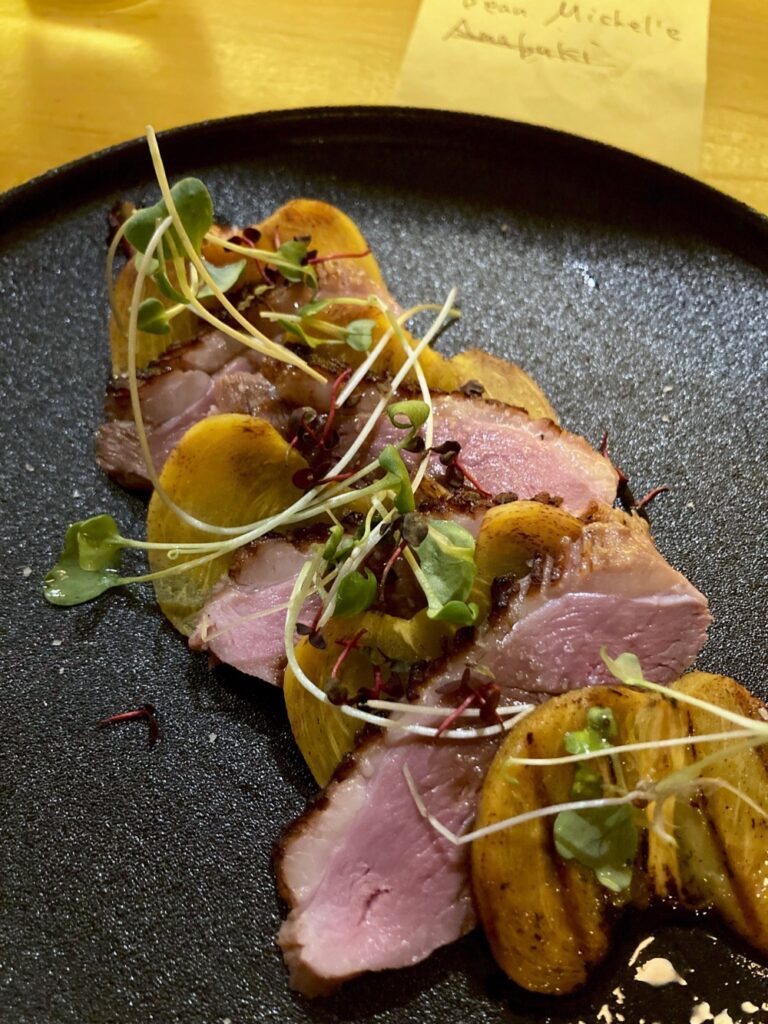
It had been a quick minute since my Saturday morning routine involved running to the St. Lawrence Market looking for what I used to think was the best food and free samples in Toronto. The City where I studied music, drank my first Đu Đủ (papaya) smoothie, and slurped my first pad thai has changed a lot win 15 years. So when I set off my temporary home past the eastern tip of Little India to the Saturday morning farmer’s market, it was as much about the journey (seeing what new restaurants existed on the way) as the destination. And for everything that’s changed (the north market Reno), just as much seems to have stayed the same (the Farmer’s Market strudel).
Gone are the Blood location of the Vietnamese hangout near campus I went to for lunch when I wanted a bowl of comfort but didn’t have the money; the AYCE sushi place I’d occasionally splurge on before I started learning about unsustainable seafood, and the upstairs space serving my favourite hot-sour-salty-sweet noodles have all closed, at least in their original locations.
The food writer who informed me (indirectly) about all of these has also passed away.
And while that strudel is miraculously still around (and still gorgeous), I, alas, am now gluten intolerant (and likely less gorgeous, though when I asked the strudel, it was respectfully silent).
Other things that are the same are the mustards at Kozlik’s. But the days when you’d be able to dip seared cubes of pork or pretzels into each one to test are over. Now you can request pretzels and the employee will dip one for you). Kozlik’s prices are up just $1 (inflation). But they’ve expanded with a line of hot sauces.
Here are my other two cents about restaurant and food industry changes in Toronto:
Small Plates are In
Donna’s, in a formerly sketchy Bloordale area at Landsdowne north of Bloor, serves excellent small plates including blanched peas on crushed pea puree with seared onions, cuttlefish with a vinegar-laced green sauce, radishes and beautifully bitter frisée; and crispy-skinned trout fillet with Japanese white turnips in butter and horseradish cream.
Japanese small plates were in before I left, but they’re ubiquitous now, including at Basement Bar New Retro, which has taken over the homestyle-meets-upscale Japanese counter below Zakkushi on Carlton at Parliament. The sake list is still excellent, especially by-the-glass, and the new chef maybe has some haute French skills (don’t skip the duck breast – first photo at the top of this post), but the menu is smaller. Do order the octopus if you arrive while the chef is slowly dipping each end of a giant arm into a massive pot of liquid to tenderly blanch it pre-service.
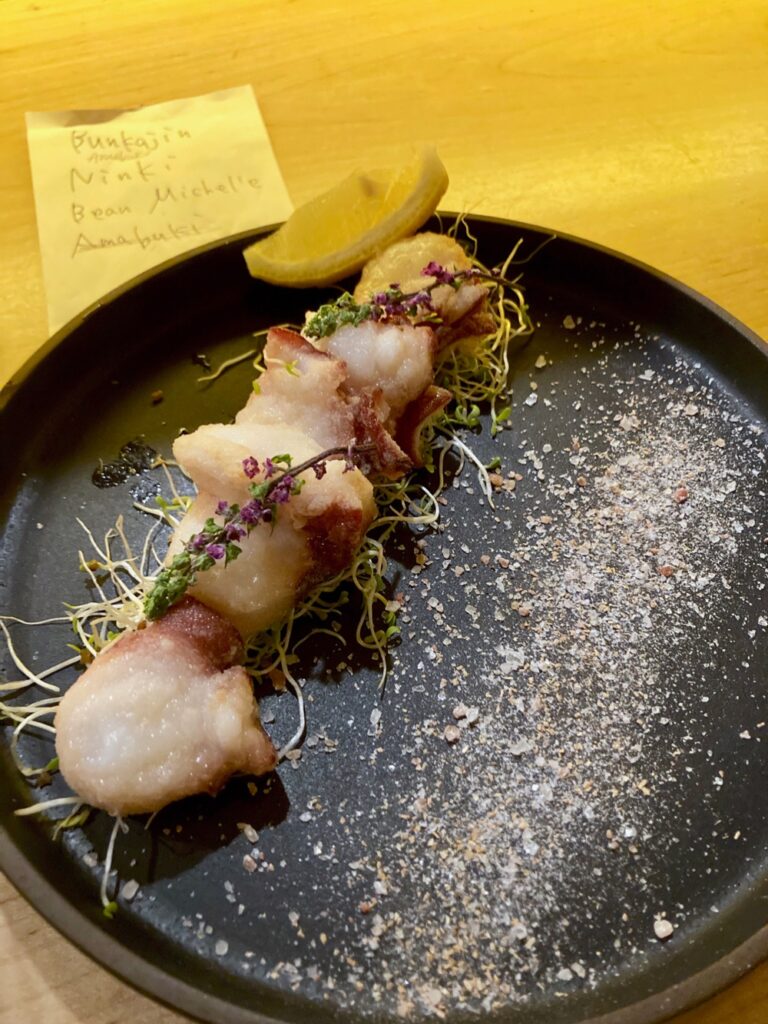
Freshly Poached Octopus at Basement Bar New Retro
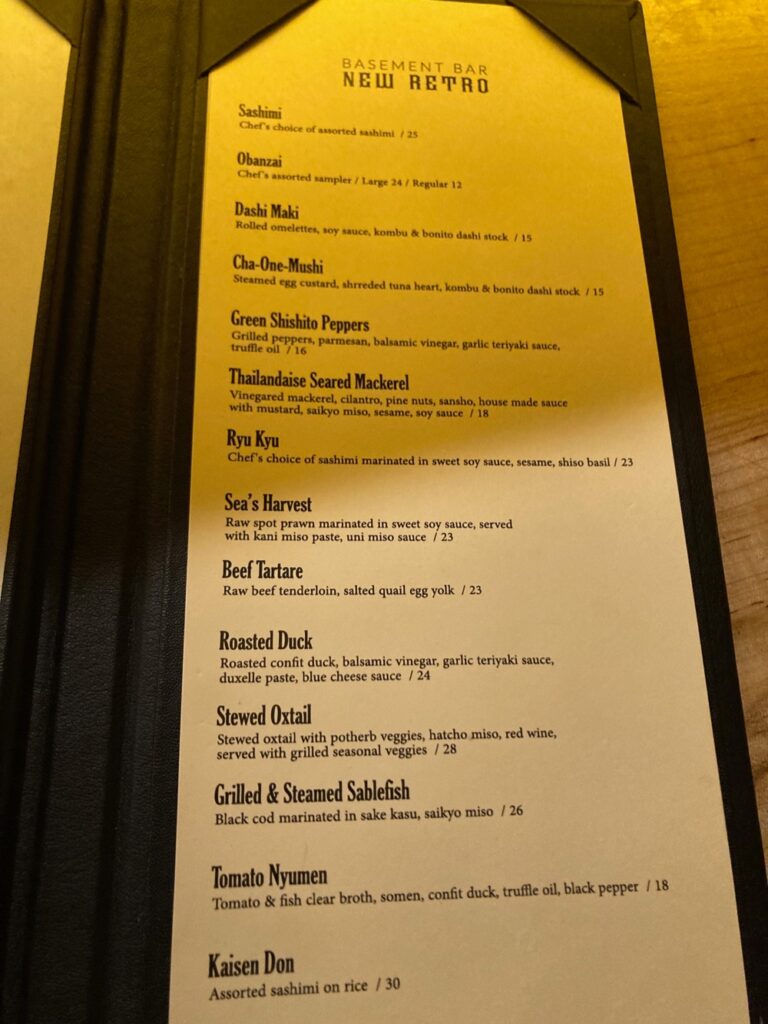
Menu at New Retro Basement Bar below Zakkushi on Carlton
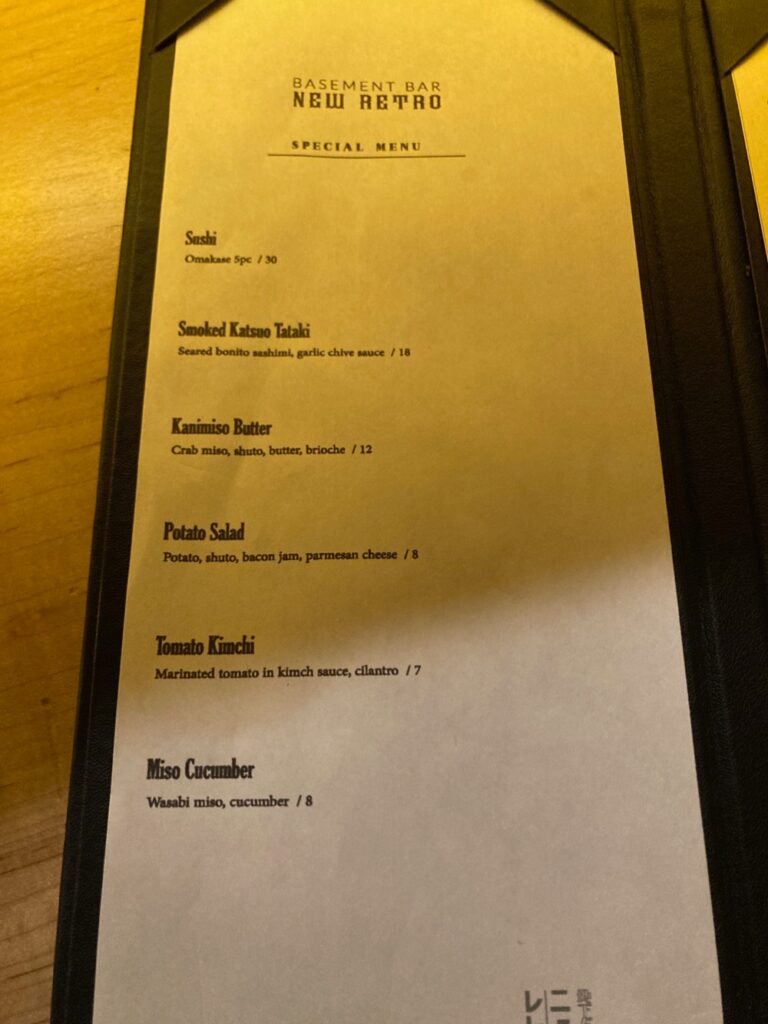
Special set menu
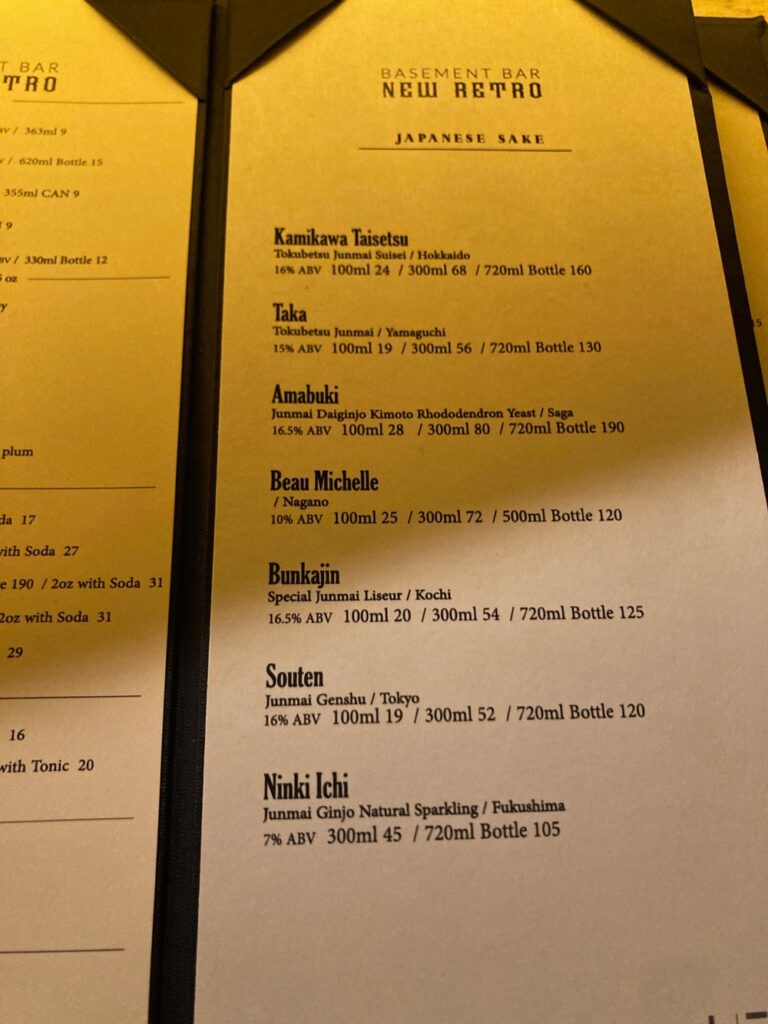
Not cheap, but not overpriced, and very interesting sake selection by the glass, half bottle and bottle.
Here are my unedited notes from dinner and the ad hoc sake tasting I ended up doing:
Beau Michelle is dijestif
Ninki is 7 percent and sparkling. Not sweet. Watery and fresh
Amabuki is a bit sweeter but lower acid so maybe not. Lovely.
Bukajin is good balance but harsher acidity.
I like the amabuki a little warmer to bring out the acidity from the kimoto method
He’s making me duck with persimmon and balsamic
And the sablefish with white miso and ?
My friendly server likes the kanikawa taisetsu best. Starts sweet ends spicy?
70s music. Very retro. In Spanish Harlem with frank Sinatra type New York resort boulevard music.
Duck is amazing. With balsamic. Confit breast but blow torched skin, so not fatty, but just enough fat to soak into meat and coat grilled persimmons
I normally hate truffle but the truffle salt is amazing. The persimmon adds a little more firmness to the chewy duck. Subtle. Just adds sweetness and texture. Thinly sliced like duck.
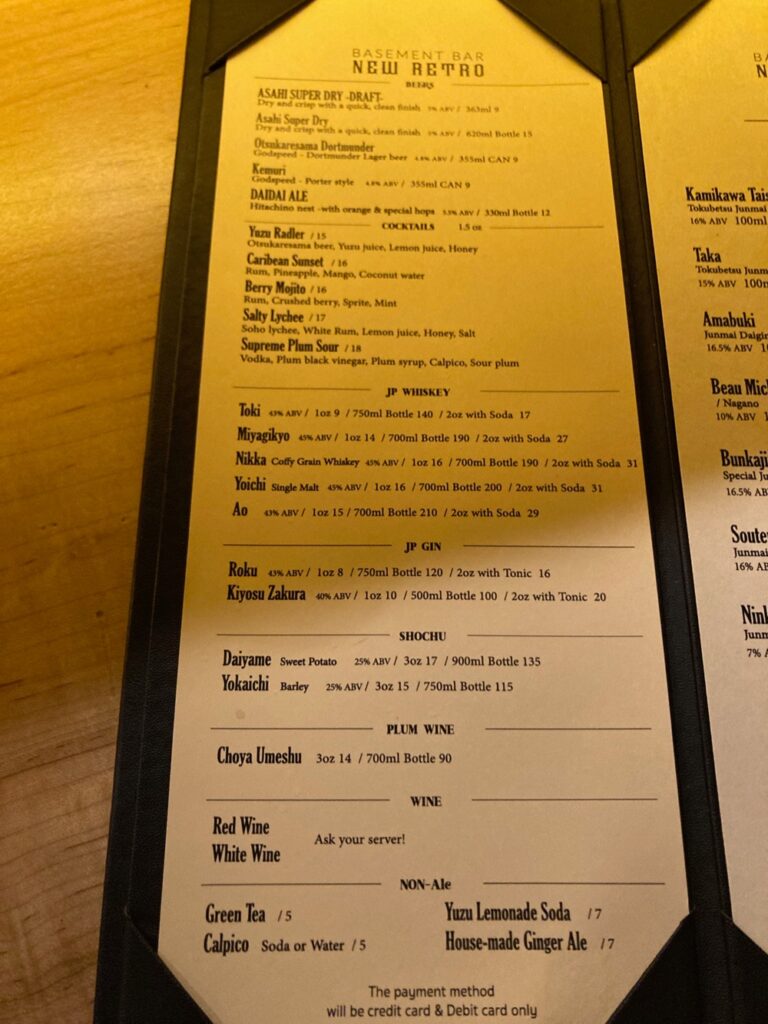
Cocktails, beer and non-alcoholic drinks menu at Basement Bar New Retro.
Sakai Bar is where I will switch up my sake drinking, though. The owner, Stuart, is passionate and very knowledgeable about sake. I also had excellent small plates there that the chef adapted to gluten-free for me. And I recently saw on Instagram that the ume plums are in! They also sake to go from the bottle shop (along with those plums, candles and gorgeous ceramic sake carafes and glasses)
While I’m ranting about sake and plums, I should mention Ki Modern Japanese, where my former instructor Michael Tremblay has crafted the most exceptional sake list in the city. Prices are reasonable, and the rest of the staff are well trained. I didn’t go for the food, but I respected the lack of kanikami (fake crab) in the snow crab roll. I’d say the skewers and karaage are likely a better deal and larger draw than the sushi if you’re a purist, but it’s a beautiful space and a very welcoming place to learn about sakes, from cult favourite Zaku, to strawberry yeasts and stereotype-breaking (and chocolatey) futsu Josen one cups from Amabuki, to floral and thick Junmai daiginjo from Okunomatsu. The 300 mL bottles mean lower prices for people wanting to explore the menu instead of investing in pricy 720 mL options.
Then there’s Izumi, Toronto’s only sake brewery, and one of just a couple in Canada. It’s grown up right along side me these 15 years. Now it has a full line of options in LCBOs (I’ve written about my favourite dry nigori before), but they have a bunch more options at the brewery.
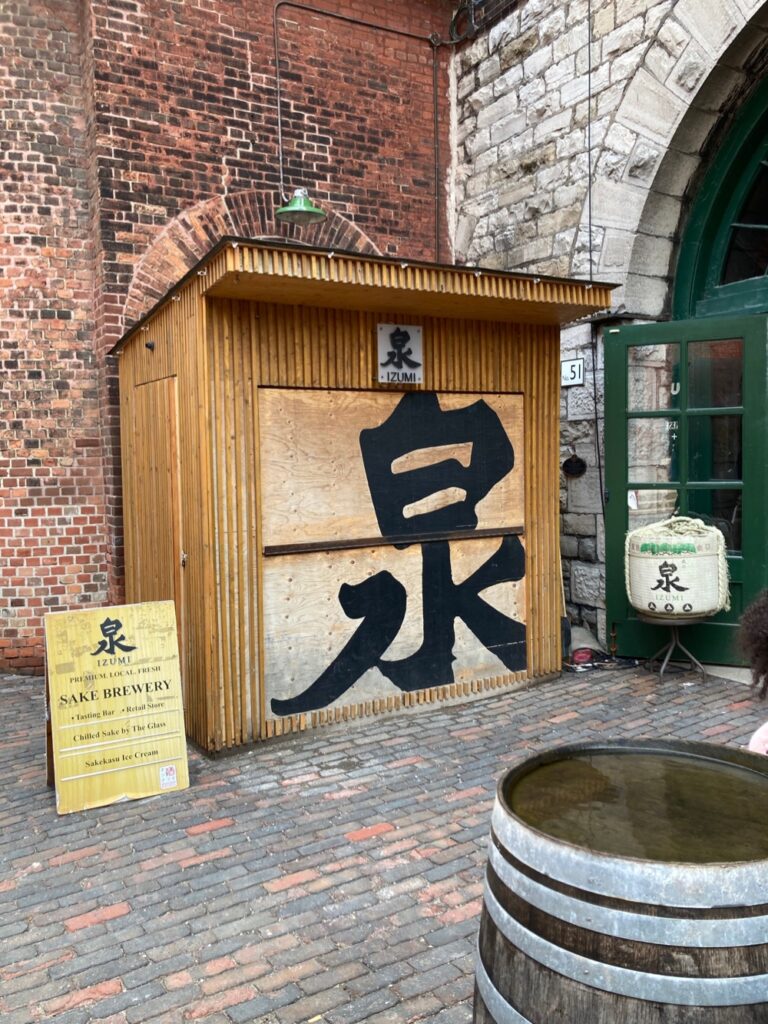
I’d been trying to taste the Arabashiri (free run press) freshly bottle options for a couple years and I finally made it. Each bottle is dated, and has slightly different aromatic and tasting notes depending on the batch, from chestnut to apricot, so I bought three different months to compare:
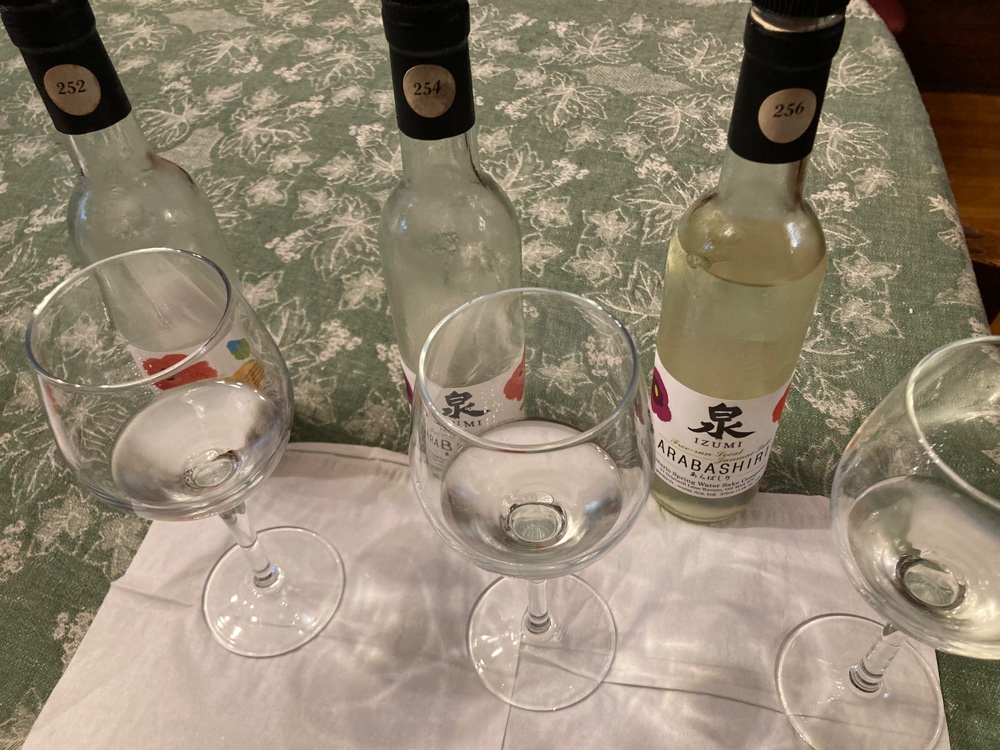
The earlier spring arabashiri sake from Izumi seen here was the sweetest and thickest, with the most acidity to balance the sugar. These are all 17.5% abv, so they’re richer and bigger flavour in that sense, but with enough floral and fruity notes to give them a lot of elegance. I liked the softness and slightly lower acidity of the middle one with more peach and stone-fruit. And the third was softer still, with more melon. So while all three were similar, it was fascinating to taste the three at the same time to try to detect the differences. And since they’re always releasing new options, there’s always something new to try.
I also bought the Nama Nama (fully unpasteurized, unlike the Nama cho available in LCBO’s, which is pasteurized once instead of the typical twice – after pressing and at bottling). You have to buy all of these at the Brewery directly, but it’s worth going to get that Nama Nama, which tastes oh-so-drinkable and easy because of the lower alcohol level. It stayed fruity, though, without going too far to the savoury, umami side. The nama-cho (half pasteurized), the dry nigori and the Izumi Gold are available at most LCBOs, but are also at the Brewery, where there’s a cute terrace (right, “patio” because I live in Toronto for the moment, not Quebec). I do really like the Izumi Gold, too, but it’s very different than the arabashiri and Nama Nama, with a lot more rice and lactic notes than fruity/floral ginjo notes, but I’m still learning. It’s kind of got this chocolatey milkshake thing going on, but in smell and taste only because there’s no dairy in there and it’s not ultra thick. There’s also a tasting flight option of the three most popular options and the another of all seven for just $27 – just a little more than a single glass of something exquisite at Basement Bar. There’s a time for each.
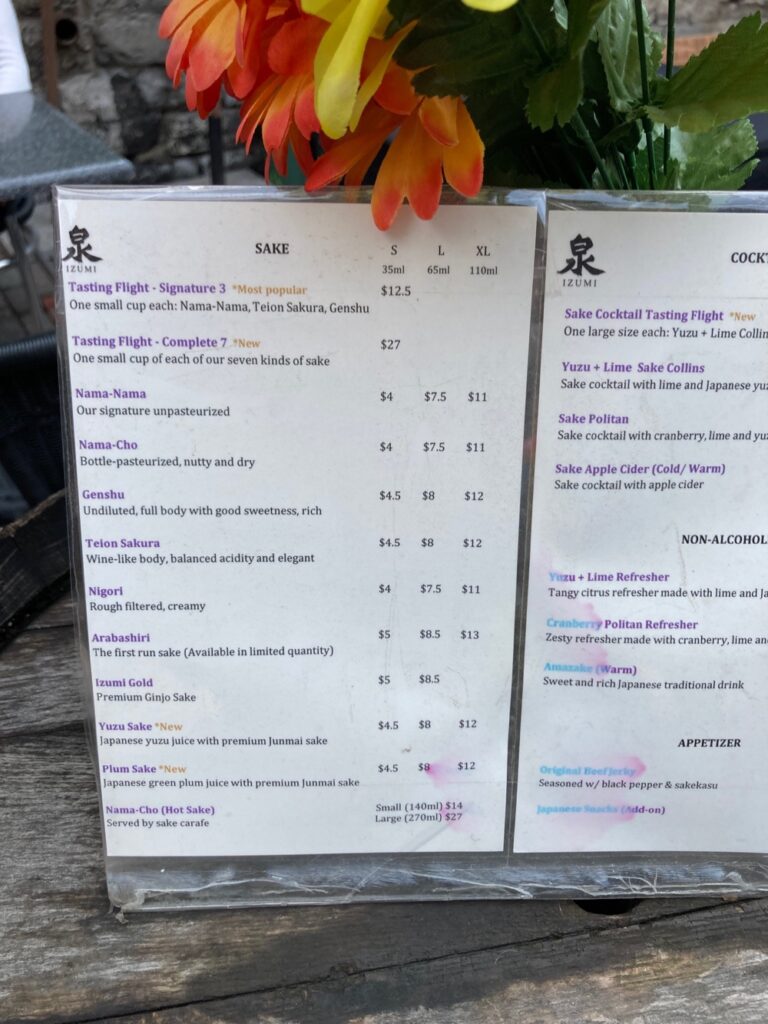
And last but not least, this summer I finally got to go to the Canada’s 100 Best Restaurants awards reception. The big to-do put on by the magazine and website I’ve written for in the past brought together a bunch of the finalist restaurants and mixologists from Newfoundland to BC for a big party above the flagship LCBO at the Sugar Wharf Development in downtown Toronto. It was the most fun food party I’ve attended since Terroir (sustainable food fest) or maybe MadeWithLove (national cocktail competition I’ve gone to a bunch in Montreal). My favourite food/drink of the evening was this:
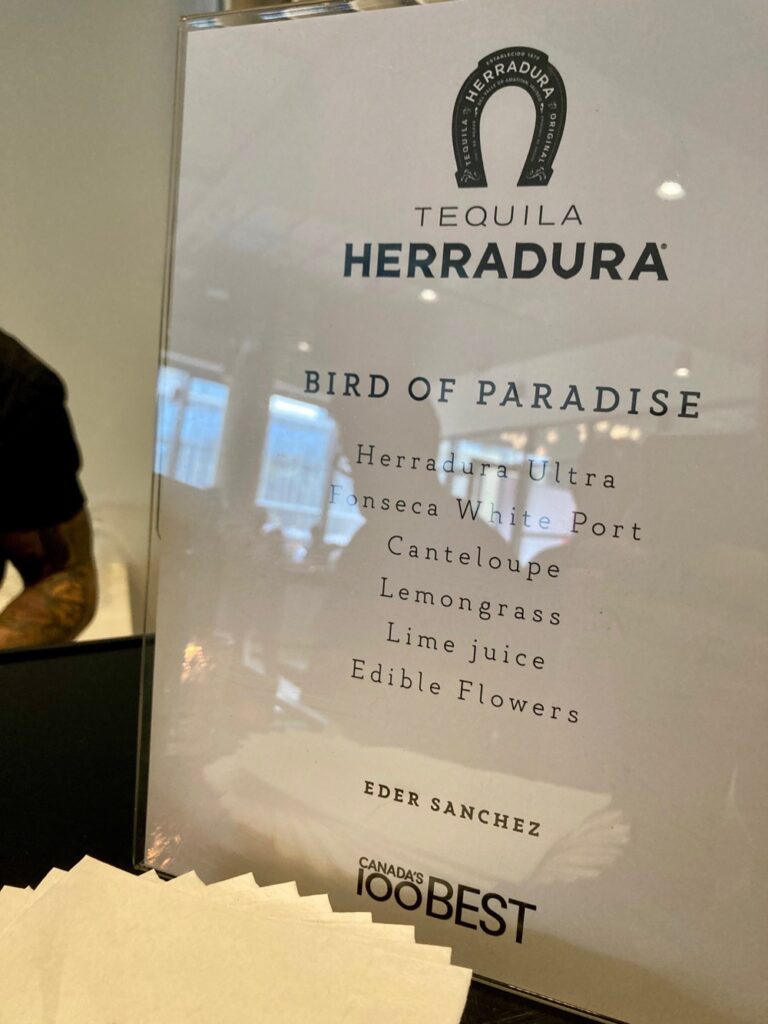
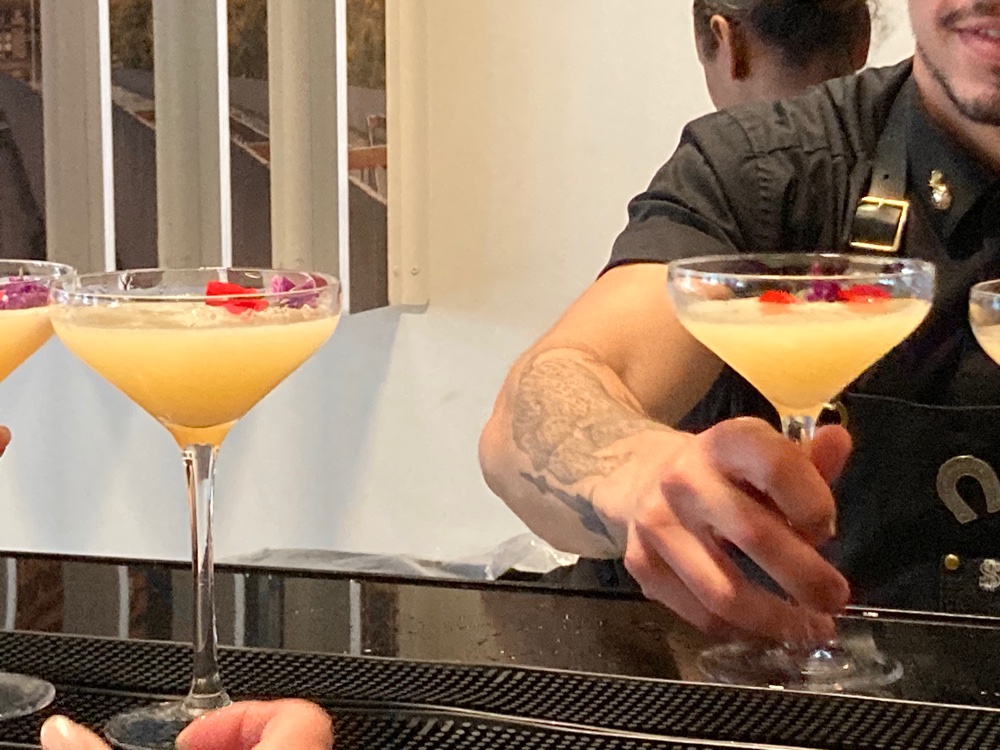
The Bird of Paradise cocktail from Eder Sanchez, formerly of Quetzal, was the craziest and most brilliant balance of white port, tequila, cantaloupe, lemongrass and lime juice. That cantaloupe was incredibly floral. I could sniff that cocktail for days. Apparently he gets his fruit pressed into fresh juice for him by a juice bar on maybe Dupont (I blame the cocktail for my poor memory). It wasn’t too sweet because that lemongrass softens it out, and the cantaloupe lowers the acidity. It wasn’t too anything. And while it took forever to get because it was made to order and everyone wanted one, it was exceptional. Follow this guy wherever he goes. The story is he was in Mexico in Tulum, I believe, and saw something described like this with cantaloupe on the cocktail menu and ordered it and was disappointed. So he said to himself, “I can make this better.” He did.
Also, I enjoyed the inexpensive grilled chicken pho at Phosome on Parliament. The broth was very salty, but that balanced the noodles well, and there was no MSG or gluten in the broth, I was told. The non-deep fried marinated tofu was also very good. I should have gotten a bit more sugar in the mango smoothie, because it was a bit watery in the end, but that was my fault for being scared of too much sugar, I think. These guys are known more for takeout and delivery, but the restaurant is cute and spacious.
I thought the Luma happy hour (Aka “Magic Hour”) with its batch-made $8 negroni sbagliato (sbagliati, but you should probably only drink one since it’s 2.5 oz of alcohol) was a boozy steal.
And I really liked my oily shrimp diablo taco experience at Playa Cabana on St. Clair.
But I think my favourite thing in Toronto so far has been the Evergreen Brickworks Market, which has boomed since I left. The prices of organic fruits and vegetables is very reasonable. Three giant lettuces or arugula for $5, two massive bok choy for $5, and a $4.50 rhubarb-filled mochi. Having spent a day making mochi by machine and by mallet back in Montreal (washing rice, soaking rice, steaming rice, pounding rice, shaping rice, packaging rice), I know the work involved. And that rhubarb filling was stupendous. Not as sweet as red bean, but I didn’t try the sesame and red bean flavour to compare. There are also savoury mochi squares to be dipped in soy sauce. I repeat: stupendous.
I also bought some heirloom beans and stone-ground heirloom corn tortillas (the farmer grew the corn himself). Tons of ciders, wines, juices, hot sauces, paella, pupusas, Turkish gozleme, samosas, and organic meats. Highly recommended.
That’s all for now. I need to go eat.
omg yes please! need more cocktails in my system
Greetings from,
https://www.valerieseow.com/
i’m totally going for the kaisen don! nice share!